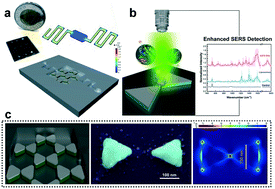Plasmonic nanobowtiefluidic device for sensitive detection of glioma extracellular vesicles by Raman spectrometry†
Abstract
Cancer cells shed into biofluids extracellular vesicles (EVs) — nanoscale membrane particles carrying diagnostic information. EVs shed by heterogeneous populations of tumor cells offer a unique opportunity to access biologically important aspects of disease complexity. Glioblastoma (GBM) exemplifies cancers that are incurable, because their temporal dynamics and molecular complexity evade standard diagnostic methods and confound therapeutic efforts. Liquid biopsy based on EVs offers unprecedented real-time access to complex tumour signatures, but it is not used clinically due to inefficient testing methods. We report on a nanostructured microfluidic-device that employs SERS for unambiguous identification of EVs from different GBM cell populations. The device features fabless plasmonic nanobowties for label-free and non-immunological SERS detection of EVs. This nanobowtiefluidic device combines the advanced characteristics of plasmonic nanobowties with a high throughput sample-delivery system for concentration of the analytes in the vicinity of the detection site. We showed theoretically and experimentally that the fluidic device assists the monolayer distribution of the EVs, which dramatically increase the probability of EV's existence in the laser illumination area. In addition, the optimized fabless nanobowtie structures with an average electric field enhancement factor of 9 × 105 achieve distinguishable and high intensity SERS signals. Using the nanobowtiefluidic and micro-Raman equipment, we were able to distinguish a library of peaks expressed in GBM EV subpopulations from two distinct glioblastoma cell lines (U373, U87) and compare them to those of non-cancerous glial EVs (NHA) and artificial homogenous vesicles (e.g. DOPC/Chol). This cost-effective and easy-to-fabricate SERS platform and a portable sample-delivery system for discerning the sub-population of GBM EVs and non-cancerous glial EVs may have broader applications to different types of cancer cells and their molecular/oncogenic signature.



 Please wait while we load your content...
Please wait while we load your content...